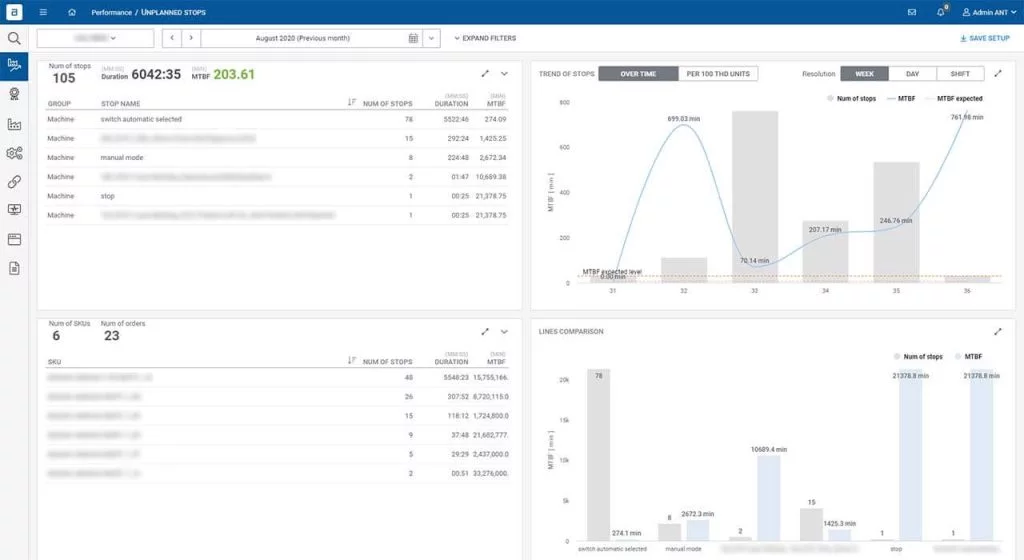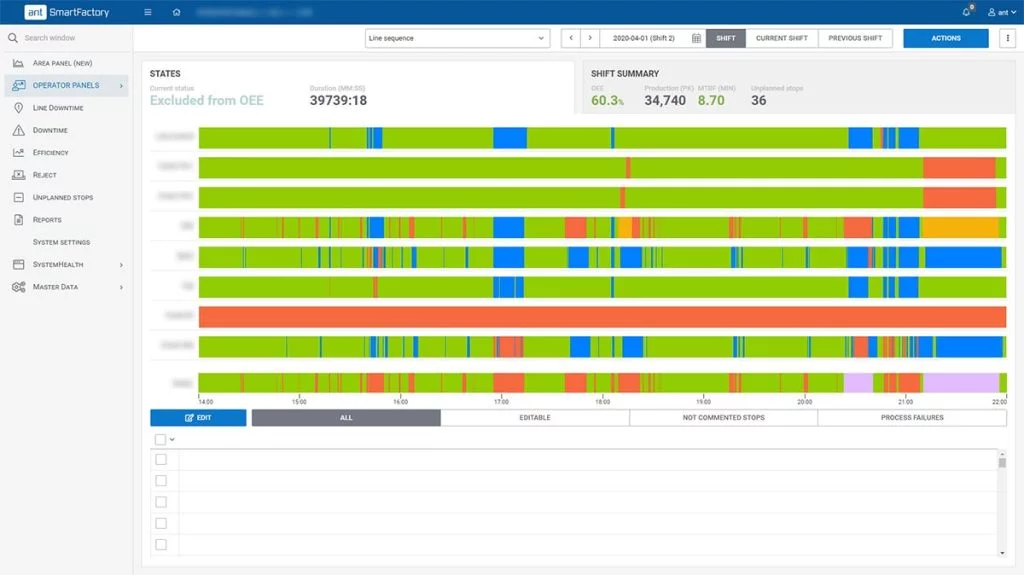The factory was in a phase of digital transformation, which included digitalization, working methodology, and IWS ready methodology. Tobacco production is characterized as a high-speed volume and involves the production of 10 thousand pieces per minute. All microstops are noticeable and have a significant influence on the production results. Machines’ availability is affected by plenty of changeover numbers on the ground of lots of Stock Keeping Units (SKUs) and all changeover times must be monitored and minimized. The machine park of the factory is very diverse. It includes many different technologies, many machines suppliers, and many machine models from the 70s to the present.
Requirements for the implementation
The factory needed a solution for real-time data collection, fast and consistent analysis, supporting Integrated Work System (IWS) ready methodology, which is based on two principles: to strive to reach zero losses during the manufacturing process, and 100% employee ownership. A crucial factor in the process of implementation was the minimization of waste, which could be achieved through lean activities to increase Mean Time Between Failures (MTBF) and minimize short and frequent downtime. Overall Equipment Effectiveness (OEE) is a standard for measuring manufacturing productivity, and it’s built from three components: performance, availability, and quality. Increasing performance, which takes into account anything that causes the manufacturing process to run at less than the maximum possible speed when it is running, can influence the effectiveness of the processes.
The group started to prepare a standardization for factories processes, Key Performance Indicators (KPIs), and requirements. Due to business requirements, the system must be able to automatically identify the root causes of any microstops longer than 5 seconds. This is because it’s impossible for the operator to report every single stop – the ones that are shorter than 5 seconds are treated as a machine fluctuation. Management wanted to achieve quick wins thanks to the analysis and reduction of the most common microstops causes.
The changeover process typically involves tasks such as identifying the tools or machine parts that a product needs for production and replacing unneeded parts in production equipment with those currently required. The factory wanted to monitor and reduce changeover time because it brings a lot of benefits, such as giving the factory more time for other processes. This can be especially valuable for companies that make a large number of products because high changeover time can reduce the time that operators actually spend each day on making the products. Paying attention to changeover time can be important for any manufacturing facility because reducing it can help a company save money and produce more products in the given time.
The company wanted active support for the operators using the Operator Panel with a task list, and progress tracking, as well as the elimination of time spent for collecting data and double reporting. Furthermore, they wanted to display the digital documentation for the current stops and issues on the production line, and to remind operators about periodic activities such as lubricating, cleaning, and inspecting. They also wanted integration with the local Manufacturing Execution System (MES) by placing the new system in the factory environment.

Solutions implemented by ANT
The factory decided to implement the ANT Microstops System. One of the most crucial things in the whole project was to prepare the concept of data acquisition from the machines. Here are some of the used methods:
- Database connection – allows client software to talk to database server software, whether on the same machine or not.
- Web services – a software system that supports interoperable machine-to-machine interaction over a network.
- TwinCAT ADS – an assembly of functional groups used for the control and regulation of axes or of synchronized axis groups.
- SIEMENS TCP – a connection-oriented communications protocol that facilitates the exchange of messages between computing devices in a network.
- OPC UA/DA – standard for the secure and reliable exchange of data.
- Files sharing – practice of sharing or offering access to digital information or resources.
ANT Solutions introduced monitoring of line operating time with automatic reporting of production, miscrostops, downtimes, partial waste as well as monitoring of machines’ operations and changeovers. For better communication with the operators, touch panels got installed. Furthermore, there’s a possibility of calculating KPIs in many various ways, for example by shift, day, week, machine, area, etc.
The factory has been equipped with dedicated performance analysis based on the Pareto chart, which is a specialized bar chart that displays categories in descending order and a line graph representing the cumulative amount. The chart effectively communicates the categories that contribute most to the total. Pareto’s charts are useful for finding the most common types of microstops to prioritize in order to see the greatest overall improvement.
To answer factories’ needs, digital documentation has been introduced. The way it works is that the system knows that a machine has stopped due to a particular reason, so it displays proper documentation in order to solve this issue as quickly as possible. In addition, the factory was provided with defect handling – the system reports a defect on the machine or problem that can be handled in free time, so constant improvement is possible, and the risk of being surprised by an unexpected defect is minimized.

Business benefits and further steps
Implementation of the Microstops System by ANT Solutions brings a lot of benefits for the business. Its results can be easily noticed by looking at the numbers and comparing them to the ones from before implementation. To sum up, Overall Equipment Effectiveness increased by 20%, Mean Time Between Failures increased by 115%, and saving time for reporting and analysis reached 80%. What’s more, the implementation allows for easily finding the most common root causes of availability and performance problems, and for reducing Mean Time to Repair (MTTR) indicator.
In the factory, some of the failures can be quickly repaired by the operators, so they don’t significantly affect the continuity of production. The next step is Anonymous Maintenance – training operators to maintain the machine themselves by preventive actions, which saves a lot of time as well as resources.
Products in this Article

Microstops monitoring
MIcro stopsmonitoring Stop the stops The most effective system for FMCG for monitoring production rates and downtime Schedule a Demo Addressing Micro Stops and Downtimes

Manufacturing Operations Management System (MOM)
Manufacturing Operations Management System (MOM) The most complete manufacturing solution with full support for operations management and a link between industrial automation and business operations

OEE Performance monitoring
Performance Monitoring (OEE) Connect and gather data from your machines. Schedule a Demo They Trusted Us: Key Benefits OEEincrease ✔️ shorter downtimes ✔️ faster production

